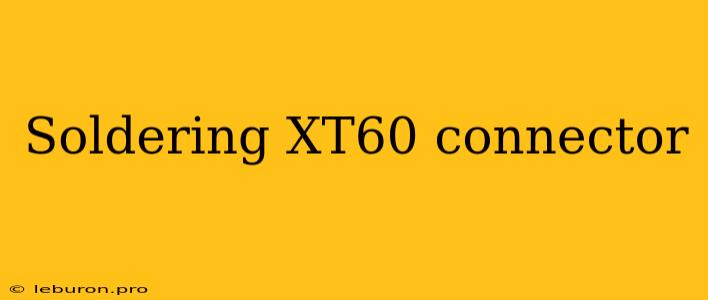Soldering XT60 connectors is a fundamental skill for anyone working with electronics, particularly those involved in building and repairing drones, robots, and other hobbyist projects. The XT60 connector, known for its robust construction and high current capacity, is a popular choice for powering these devices. This article will guide you through the process of soldering XT60 connectors, ensuring you achieve a reliable and durable connection.
Understanding the XT60 Connector
The XT60 connector is a two-pin connector, consisting of a male and a female component. The male connector features a central pin that connects to the positive terminal of the battery or device, while the outer shell connects to the negative terminal. The female connector mirrors this structure, providing a secure connection for the male counterpart.
The XT60 connector is designed for high-current applications, making it ideal for powering electronics that require significant power, such as electric motors, ESCs (Electronic Speed Controllers), and high-power LED lights. Its robust construction, typically featuring a nylon housing and gold-plated contacts, ensures reliable conductivity and long-term durability.
Essential Tools and Materials
Before you begin soldering XT60 connectors, gather the necessary tools and materials. These include:
- Soldering Iron: A temperature-controlled soldering iron with a suitable tip size for working with the connector pins.
- Solder: Lead-free solder with a low melting point (typically 60/40 or 63/37 tin/lead ratio) is recommended.
- Flux: Soldering flux aids in the flow of solder and promotes a clean connection. Rosin flux is commonly used for electronics soldering.
- Wire Strippers: A wire stripper designed for the size of wires you will be using.
- Heat Shrink Tubing: To insulate and protect the soldered connections, heat shrink tubing slightly larger than the connector is required.
- Optional: Helping Hands: A helping hands tool can hold the connector in place while you solder.
- Wire: Choose a wire gauge suitable for the current requirements of your application.
Preparing the XT60 Connectors
-
Clean the Connectors: Before soldering, clean the connector contacts with a small amount of isopropyl alcohol. This removes any oxidation or contaminants that could affect the connection.
-
Strip the Wires: Strip a short length of insulation from each end of the wires you will be connecting to the XT60 connectors. The length should be sufficient to make a secure connection inside the connector.
-
Prepare the Connectors for Soldering: If you are using the pre-crimped connectors, skip this step. If you are using bare XT60 connector pins, you may need to use a crimping tool to attach the wire to the connector pin. If using bare pins, insert the stripped wires into the connector and ensure they are firmly in place.
Soldering the XT60 Connectors
-
Heat the Connection: Use the soldering iron to heat the connector pin and the wire at the point of connection. The goal is to melt the solder, not burn the insulation.
-
Apply Solder: Once the connection is heated, feed a small amount of solder into the joint. The solder should flow smoothly and evenly, creating a strong and reliable connection.
-
Remove the Iron: Carefully remove the soldering iron once the solder has solidified. The joint should have a shiny, smooth appearance, indicating a good connection.
-
Repeat for Other Wires: Follow the same steps for each wire you are connecting to the XT60 connector.
Finishing Touches
-
Insulate the Connections: After soldering, slide a piece of heat shrink tubing over the soldered joint and carefully heat it with a heat gun or lighter. This insulates the connection and protects it from moisture and accidental shorts.
-
Test the Connection: Once the heat shrink tubing has cooled, it's essential to test the connection with a multimeter. Ensure there is continuity between the appropriate terminals and that there are no shorts between them.
Soldering XT60 Connectors: Best Practices
- Cleanliness: Maintain a clean workspace. Contaminants and oxidation can affect the quality of the soldered connections.
- Solder Quantity: Use only a small amount of solder to ensure a strong and secure connection without creating a cold joint.
- Proper Technique: Use a steady hand and ensure the soldering iron is properly heated to create a quality connection.
- Safety: Always wear safety glasses and take precautions when working with hot soldering tools.
Conclusion
Soldering XT60 connectors is a fundamental skill for anyone working with electronics. With the right tools, materials, and techniques, you can create reliable and durable connections for your projects. By following the steps and best practices outlined in this article, you can confidently solder XT60 connectors and ensure the successful power delivery for your electronics. Remember to practice patience and focus on cleanliness and proper technique for optimal results.
